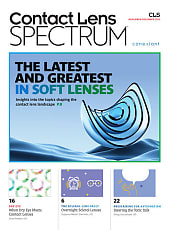What does it mean to be an athlete? At the International Sports Vision Association Combine in February in Bentonville, AR, three world-class athletes spoke of the role sports vision played in their wins. Notably, these athletes—Qadry Ismail, a 2001 Baltimore Ravens Super Bowl champion; Maggie Steffens, a three-time women’s water polo Olympic gold medalist; and Anneke Beerten, a three-time world champion mountain bike racer—all talked about flow. They described that when bodies, minds, and eyes work together perfectly, sport feels intuitive and exhilarating. From their discussion, a new definition of athlete emerged: An athlete is a person who seeks flow state through movement with tenacity. That may look like a star wide receiver, but it also may look like every member of the adult softball league in your town.

The athlete, however, cannot be treated as a patient. To a pro athlete, being called a patient can signal bench time or, at worst, the end of a career. Similarly, if we treat the more casual athlete like a patient, we are missing the ability to help them see their vision as already amazing but capable of being even better. And better sports vision makes our fun, well, more fun.
It is a perfect time to be building a comprehensive sports vision practice for any athlete. Most family practice optometrists are concerned with the diagnosis of eye health issues and offering patients their best visual acuity in lenses. Sports vision practices not only deliver an athlete’s perfect vision, but they help injured athletes get back in the game faster and enhance the cognitive abilities of all athletes using visual therapies and lenses.
Here’s how to achieve the best sports lenses:
Rule No. 1: All sports vision eyeglass lenses deserve to be digitally compensated.
Wrapping a frame without compensation does a number on the visual acuity of the patient. In every case, including plano lenses, if compensations are not made, there will be unwanted, unintended base out prism. While the amounts of prism induced are less than American National Standards Institute (ANSI) tolerances, they are not zero, causing the brain to compensate where lenses do not.
What’s more, wrapping a lens with power induces unwanted astigmatism. To avoid these issues, it’s not enough simply to order a lens that is digitally compensated for position-of-wear elements like vertex distance, pantoscopic tilt, and face form. We also must communicate the base curve of the demonstration lens in a frame and order a wrap-specific lens in addition to providing these measurements. The best lens design ensures light will be focused perfectly at every angle.

Rule No. 2: All sports vision eyeglass lenses should be shatter resistant.
While polycarbonate lenses may be the most shatter resistant, they are optically the least clear with the most chromatic aberration. Trivex, 1.60, and some proprietary lens materials are also sufficiently protective. There is a misconception that sport lenses should be safety thickness. According to Michael Vitale, ABOM, vice president; membership, government relations, & technical affairs at The Vision Council, this is simply not true. Sports standards are not Occupational Safety and Health Administration (OSHA) standards.
Rule No. 3: Every sports lens needs a coating.
At the very least, a sports lens deserves an extra-hard scratch coat. Sport eyewear is a piece of sports equipment and needs to be built tougher than most. The best antireflective coating allows less scattering of light in the lens and will stop any light and UV from behind from being reflected back to the eye. Antifog lens coatings can work in combination with AR to help keep lenses from fogging in moist or sweaty environments. Mirrors can keep an opponent from detecting eye movement, giving away clues to the player’s next move.
Rule No. 4: Use the right colored lens for the game.
Keep Your Head in the Game
Want more sports vision intel? EB caught up with Cira Collins to hear insights into her Vision Expo East course, “Work Hard, Play Harder: Sports Vision In Motion.” Click here to read on. Plus, to learn more about becoming a sports vision practice, visit the International Sports Vision Association at sportsvision.pro.
Generative artificial intelligence (AI) is changing the game on how we use colored lenses. With AI, hundreds of thousands of images can be interpreted, identifying which colors in various lighting conditions need to be enhanced to make the target—like a ball—pop, and which colors could be suppressed to make the environment less distracting. AI then can produce the perfect tint formula for every sport.
Rule No. 5: Sports-specific eyeglasses work only if you use them.
If a basketball player takes a ball to the eye, they likely blink and move on, but a finger poke could put them out of the game. There is no sport where the appropriate eyewear does not offer protection. But if the frame lacks the “cool” factor or if the vision is compromised by less-than-enhanced vision, the eyewear does not get worn. You have to offer styles that are functional and appealing, then insist on the lens design, materials, and coatings to make them function.
By investing in the knowledge, products, and enhancements that are available today, we can enhance vision, cognitive ability, performance, and, most importantly, fun! —CIRA COLLINS, MPH, ABOM, NCLEC



